airbag MITSUBISHI MIRAGE G4 2019 Owner's Manual (in English)
[x] Cancel search | Manufacturer: MITSUBISHI, Model Year: 2019, Model line: MIRAGE G4, Model: MITSUBISHI MIRAGE G4 2019Pages: 267, PDF Size: 38.31 MB
Page 5 of 267

Instruments and controls 1-1
1
Overview
N00100202876
Instruments and controls
Instrument cluster P.5-64
Hazard warning flasher switch P.5-82
Combination headlights and dimmer switch P.5-79 Turn-signal lever P.5-81 Front fog light switch (if so equipped) P.5-82
Wiper and washer switch P.5-82
Cruise control switches (if so equipped) P.5-55
Engine switch (if so equipped) P.5-13
Ignition switch (if so equipped) P.5-37
Active stability control (ASC) OFF switch P.5-53 Electric remote-controlled outside rearview mirror switch P.5-36
Supplemental restraint system (SRS)-air- bag (for driver) P.4-22, 4-28 Horn switch P.5-85
Steering wheel height adjustment lever P.5-34
Steering wheel remote control switches [Refer to the separate owner’s manual.]
Supplemental restraint system (SRS)-driver’s knee airbag P.4-22, 4-29
Fuses P.9-22
BK0267800US.book 1 ページ 2018年5月30日 水曜日 午後4時24分
Page 7 of 267

Interior 1-3 Overview
1
N00100302561
Interior
Bottle holders P.5-95
Power window lock switch P.5-30
Sun visors P.5-86 Vanity mirror P.5-86 Card holder P.5-86
Power door lock switch (if so equipped) P.5-26
Dome light P.5-93, 9-28
Inside rearview mirror P.5-34
Head restraints P.4-5
Power window switch P.5-30
Seat belts P.4-7
Supplemental restraint system (SRS)- curtain airbags P.4-22, 4-33 Manual window control (if so equipped) P.5-30
Tether anchorages for child restraint system P.4-17
Front seats P.4-2
Supplemental restraint system (SRS)-side airbags (for front seat) P.4-22, 4-33
Arm rest P.4-5
Jack P.8-5
Rear seat P.4-5
Cup holder (for the rear seat) P.5-94
Assist grips P.5-96
Arm rest (Driver’s seat only, if so equipped) P. 4-4
Microphone [Refer to the separate owner’s manual.]
Trunk-through lid P.4-5
Convenience hook P.5-95
BK0267800US.book 3 ページ 2018年5月30日 水曜日 午後4時24分
Page 14 of 267

If this warning light comes on or
flashes while you’re driving...
Quick index 2-3
2
Anti-lock braking system warning
light
When this light comes on,
the anti-lock braking system
is not functioning and only
the ordinary braking system is functioning. Park your vehicle in a safe
place and stop the engine.
Test the system as described on page 5-51. If the light does not go out after
the test, or if it comes on
again, we recommend that
you have the system checked at an authorized
Mitsubishi Motors dealer or a repair
facility of your choice
as soon as possible.
P. 5-50
SRS warning light
Immediately have the airbag and the pre-te
nsioner seat belt sy
stem checked at an
authorized Mitsubishi Motors dealer.
P. 4-28
Selector lever position indicator in the instrument cluste
r flashes slowly
(every 2 seconds)
Have your continuously variable transmis
sion (CVT) checked at an authorized
Mitsubishi Motors dealer or a repair
facility of your ch
oice immediately.
P. 5-45
and
ASC indicator and ASC OFF indicator
Park your vehicle in a safe
place and stop the engine.
Restart the engine and check
whether the indicator goes out.
If the indicator does not go out, or if it
comes on again, have
your vehicle inspected
by an authorized Mitsubishi Motors dealer or
a repair facility of your choice as soon
as possible. When this indicator comes on, the activ
e stability control is not functioning.
P. 5-54
Wa rn in g l ig h t s
Do this
Ref. Page
BK0267800US.book 3 ページ 2018年5月30日 水曜日 午後4時24分
Page 26 of 267
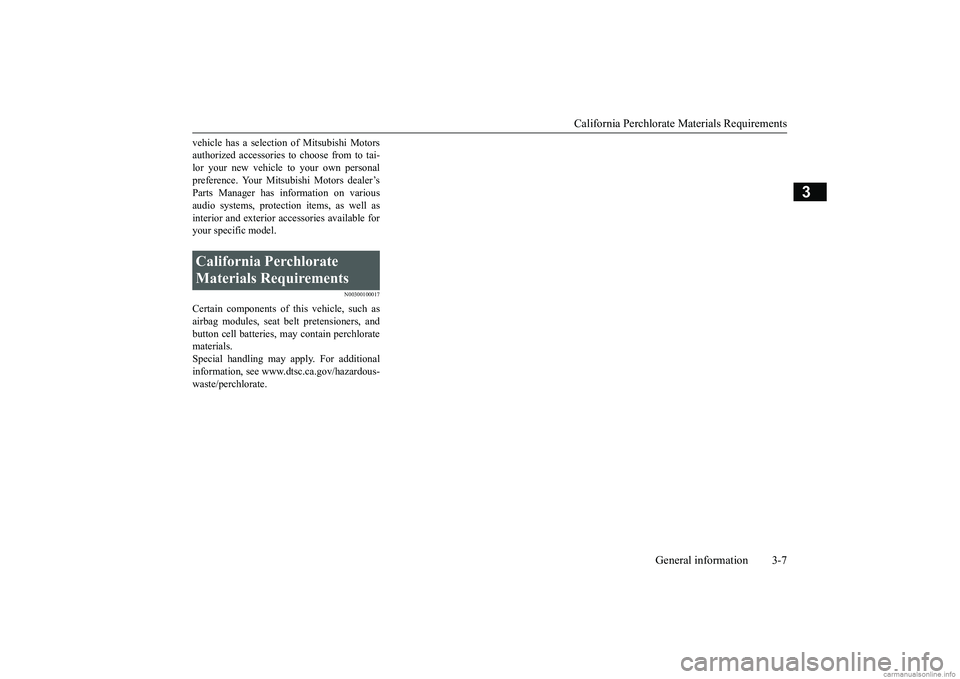
California Perchlorate Materials Requirements
General information 3-7
3
vehicle has a selecti
on of Mitsubishi Motors
authorized accessories to choose from to tai-lor your new vehicle to your own personal preference. Your Mitsubishi Motors dealer’s Parts Manager has in
formation on various
audio systems,
protection items, as well as
interior and exterior ac
cessories available for
your specific model.
N00300100017
Certain components of this vehicle, such asairbag modules, seat belt pretensioners, and button cell batteries, ma
y contain perchlorate
materials.Special handling may apply. For additional information, see www.d
tsc.ca.gov/hazardous-
waste/perchlorate.California Perchlorate Materials Requirements
BK0267800US.book 7 ページ 2018年5月30日 水曜日 午後4時24分
Page 28 of 267
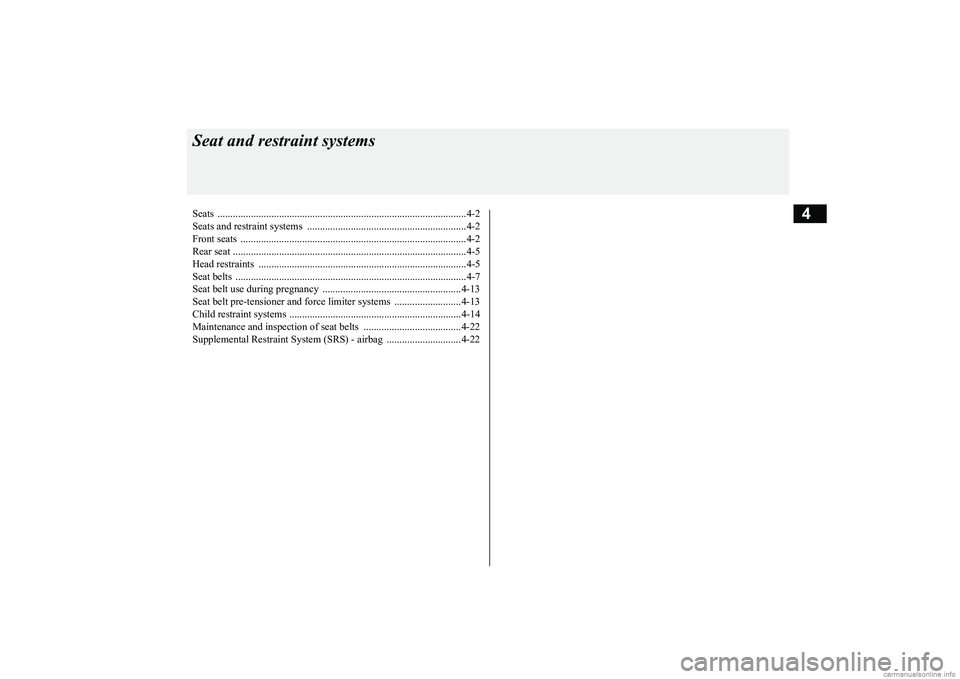
4
Seat and restraint systemsSeats .................................................................................................4-2 Seats and restraint systems ..............................................................4-2 Front seats ........................................................................................4-2Rear seat ...........................................................................................4-5 Head restraints .................................................................................4-5 Seat belts ..........................................................................................4-7Seat belt use during pregnancy ......................................................4-13 Seat belt pre-tensioner and force limiter systems ..........................4-13 Child restraint systems ...................................................................4-14Maintenance and inspection of seat belts ......................................4-22 Supplemental Restraint Syst
em (SRS) - airbag ......
.........
.........
.....4-22
BK0267800US.book 1 ページ 2018年5月30日 水曜日 午後4時24分
Page 29 of 267
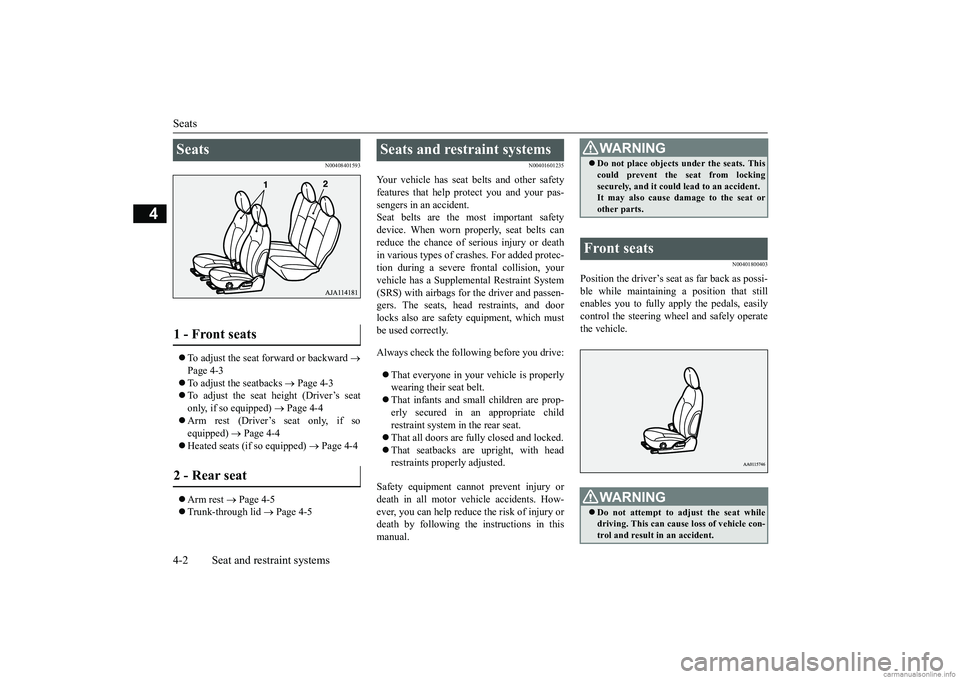
Seats 4-2 Seat and restraint systems
4
N00408401593
To adjust the seat forward or backward
Page 4-3 To adjust the seatbacks
Page 4-3
To adjust the seat height (Driver’s seat only, if so equipped)
Page 4-4
Arm rest (Driver’s seat only, if so equipped)
Page 4-4
Heated seats (if so equipped)
Page 4-4
Arm rest
Page 4-5
Trunk-through lid
Page 4-5
N00401601235
Your vehicle has seat
belts and other safety
features that help
protect you and your pas-
sengers in an accident.Seat belts are the most important safety device. When worn properly, seat belts can reduce the chance of serious injury or deathin various types of cras
hes. For added protec-
tion during a severe fr
ontal collision, your
vehicle has a Supplemen
tal Restraint System
(SRS) with airbags for the driver and passen- gers. The seats, head restraints, and doorlocks also are safety equipment, which must be used correctly. Always check the follow
ing before you drive:
That everyone in your vehicle is properly wearing their seat belt. That infants and small children are prop- erly secured in an appropriate child restraint system in
the rear seat.
That all doors are fully closed and locked. That seatbacks are upright, with head restraints properly adjusted.
Safety equipment cannot prevent injury or death in all motor ve
hicle accidents. How-
ever, you can help reduce the risk of injury or death by following the
instructions in this
manual.
N00401800403
Position the driver’s seat as far back as possi-ble while maintaining a position that stillenables you to fully a
pply the pedals, easily
control the steering wheel and safely operate the vehicle.
Seats 1 - Front seats 2 - Rear seat
Seats and restraint systems
WA R N I N G Do not place objects under the seats. This could prevent the seat from lockingsecurely, and it could lead to an accident.It may also cause damage to the seat or other parts.
Front seats
WA R N I N G Do not attempt to adjust the seat while driving. This can cause loss of vehicle con- trol and result
in an ac
cident.
BK0267800US.book 2 ページ 2018年5月30日 水曜日 午後4時24分
Page 30 of 267
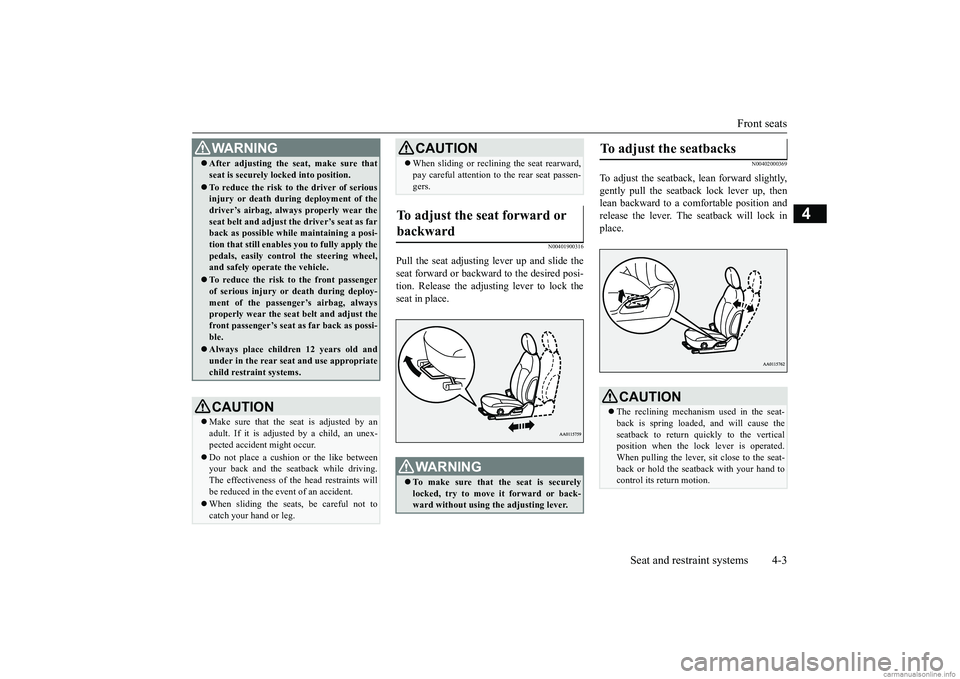
Front seats
Seat and restraint systems 4-3
4
N00401900316
Pull the seat adjusting lever up and slide the seat forward or backward to the desired posi- tion. Release the adjusting lever to lock theseat in place.
N00402000369
To adjust the seatback,
lean forward slightly,
gently pull the seatback lock lever up, then lean backward to a comfortable position andrelease the lever. The seatback will lock in place.
After adjusting the se
at, make sure that
seat is securely locked into position. To reduce the risk to the driver of serious injury or death durin
g deployment of the
driver’s airbag, always
properly wear the
seat belt and adjust th
e driver’s seat as far
back as possible while maintaining a posi- tion that still enables
you to fully apply the
pedals, easily control the steering wheel, and safely operate the vehicle. To reduce the risk to the front passenger of serious injury or
death during deploy-
ment of the passenger’s airbag, alwaysproperly wear the seat
belt and adjust the
front passenger’s seat as far back as possi- ble. Always place childre
n 12 years old and
under in the rear seat
and use appropriate
child restraint systems.CAUTION Make sure that the seat is adjusted by an adult. If it is adjusted by a child, an unex- pected accident
might occur.
Do not place a cushion
or the like between
your back and the seatback while driving. The effectiveness of the head restraints will be reduced in the event of an accident. When sliding the seat
s, be careful not to
catch your hand or leg.WA R N I N G
When sliding or reclining the seat rearward, pay careful attention to
the rear seat passen-
gers.
To adjust the seat forward or backward
WA R N I N G To make sure that the seat is securely locked, try to move
it forward or back-
ward without using
the adjusting lever.
CAUTION
To adjust the seatbacks
CAUTIONThe reclining mechanism used in the seat- back is spring loaded, and will cause theseatback to return quickly to the vertical position when the lock lever is operated. When pulling the lever, sit close to the seat-back or hold the seatback with your hand to control its return motion.
BK0267800US.book 3 ページ 2018年5月30日 水曜日 午後4時24分
Page 35 of 267
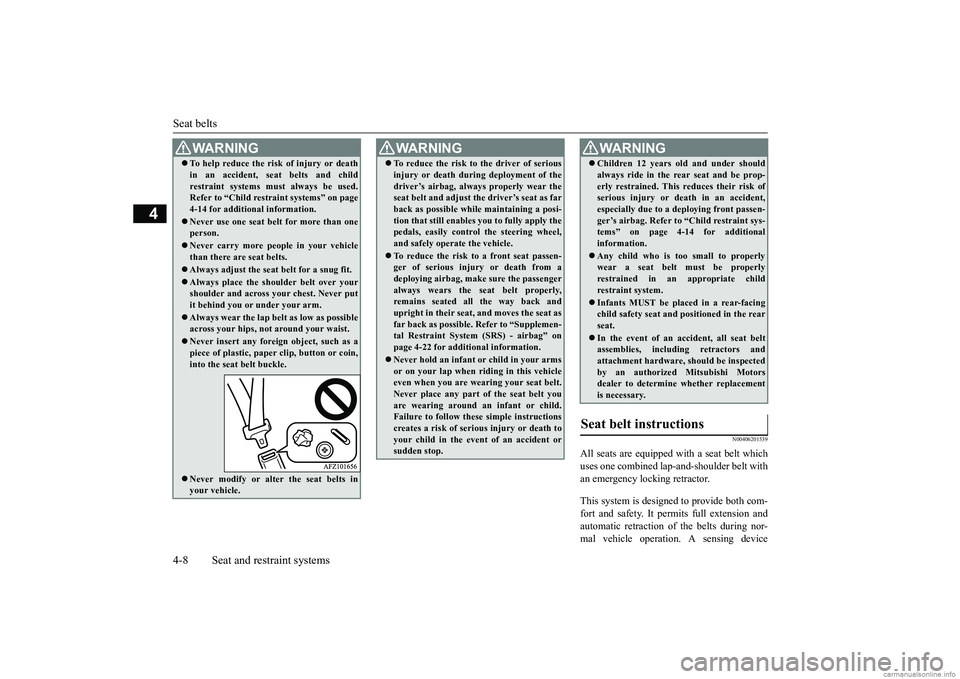
Seat belts 4-8 Seat and restraint systems
4
N00406201539
All seats are equipped with a seat belt which uses one combined lap-
and-shoulder belt with
an emergency locking retractor. This system is designed to provide both com- fort and safety. It permits full extension andautomatic retraction of the belts during nor- mal vehicle operation.
A sensing device
WA R N I N GTo help reduce the risk of injury or death in an accident, se
at belts and child
restraint systems must always be used.Refer to “Child restraint systems” on page 4-14 for additional information. Never use one seat belt
for more than one
person. Never carry more peop
le in you
r vehicle
than there are seat belts. Always adjust the seat
belt for a snug fit.
Always place the shou
lder belt over your
shoulder and across
your chest. Never put
it behind you or under your arm. Always wear the lap be
lt as low as possible
across your hips, not around your waist. Never insert any foreig
n object, such as a
piece of plastic, paper
clip, button or coin,
into the seat belt buckle. Never modify or alter the seat belts in your vehicle.
To reduce the risk to the driver of serious injury or death durin
g deployment of the
driver’s airbag, always
properly wear the
seat belt and adjust th
e driver’s seat as far
back as possible while maintaining a posi- tion that still enables
you to fully apply the
pedals, easily control the steering wheel, and safely operate the vehicle. To reduce the risk to a front seat passen- ger of serious injury or death from a deploying airbag, make sure the passengeralways wears the seat belt properly, remains seated all the way back and upright in their seat,
and moves the seat as
far back as possible. Refer to “Supplemen- tal Restraint System (SRS) - airbag” on page 4-22 for additional information. Never hold an infant
or child in your arms
or on your lap
when riding in this vehicle
even when you are wearing your seat belt. Never place any part of the seat belt you are wearing around an
infant or child.
Failure to follow these simple instructions creates a risk of serious injury or death to your child in the even
t of an accident or
sudden stop.WA R N I N G
Children 12 years ol
d and under should
always ride in the re
ar seat and be prop-
erly restrained. This reduces their risk ofserious injury or de
ath in an accident,
especially due to a deploying front passen- ger’s airbag. Refer to
“Child restraint sys-
tems” on page 4-
14 for additional
information. Any child who is too small to properly wear a seat belt
must be properly
restrained in an appropriate childrestraint system. Infants MUST be plac
ed in a rear-facing
child safety seat and
positioned in the rear
seat. In the event of an ac
cident, all seat belt
assemblies, including retractors and attachment hardware, should be inspectedby an authorized
Mitsubishi Motors
dealer to determine whether replacement is necessary.
Seat belt instructions
WA R N I N G
BK0267800US.book 8 ページ 2018年5月30日 水曜日 午後4時24分
Page 36 of 267
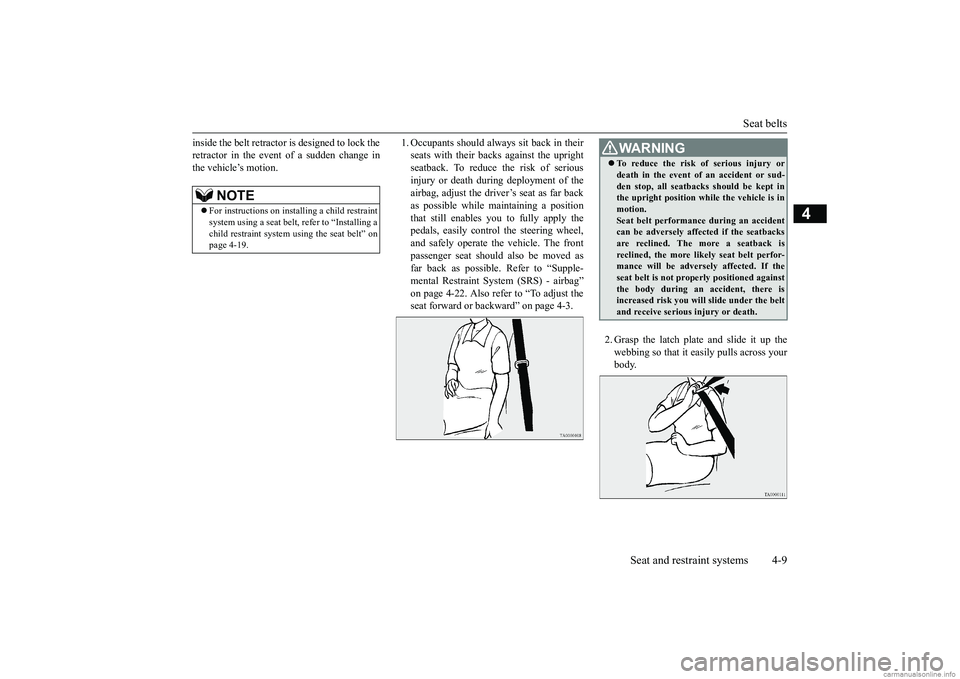
Seat belts
Seat and restraint systems 4-9
4
inside the belt retractor is designed to lock the retractor in the event of a sudden change inthe vehicle’s motion.
1. Occupants should always
sit back in their
seats with their backs against the uprightseatback. To reduce
the risk of serious
injury or death during deployment of the airbag, adjust the driver’s seat as far backas possible while maintaining a position that still enables you to fully apply the pedals, easily control the steering wheel,and safely operate the vehicle. The front passenger seat should also be moved as far back as possible. Refer to “Supple- mental Restraint System (SRS) - airbag” on page 4-22. Also refer to “To adjust theseat forward or backward” on page 4-3.
2. Grasp the latch plat
e and slide it up the
webbing so that it easily pulls across your body.
NOTE
For instructions on installing a child restraint system using a seat belt
, refer to “Installing a
child restraint system
using the seat belt” on
page 4-19.
WA R N I N G To reduce the risk of serious injury or death in the event of
an accident or sud-
den stop, all seatbacks should be kept inthe upright position while the vehicle is in motion. Seat belt performance during an accidentcan be adversely affect
ed if the seatbacks
are reclined. The more a seatback is reclined, the more likely seat belt perfor-mance will be advers
ely affected. If the
seat belt is not prop
erly positioned against
the body during an accident, there isincreased risk you will slide under the belt and receive serious
injury or death.
BK0267800US.book 9 ページ 2018年5月30日 水曜日 午後4時24分
Page 40 of 267

Seat belt use during pregnancy
Seat and restraint systems 4-13
4
2. Fasten the seat belt and make sure it fits snugly across your shoulder.
N00406700205
If your seat belt is
not long enough, even
when fully extended,
a seat belt extender
must be obtained. Th
e extender may be used
for either of the front seats.
N00406800147
Seat belts work for everyone, including preg- nant women. Like al
l occupants, pregnant
women are more likely to be seriously injuredor killed in an accide
nt if they do not wear
seat belts.
N00417701752
The driver’s and front passenger’s seats eachhave a seat belt
equipped with a pre-tensioner
system and force limiter system. The driver and front pa
ssenger seat
belts are
equipped with a seat belt pre-tensioner sys- tem. In a moderate-to-severe frontal or side collision or when a rollover or overturning ofthe vehicle is detected
, the pre-tensioner sys-
tem operates simultane
ously with the deploy-
ment of the front airb
ags, side airbags or
curtain airbags. The seat belt pre-tensioners are located within the seat belt retractors
(A). When activated,
the pre-tensioners quickly
draw back seat belt
webbing and increase se
at belt performance.
Seat belt extender
WA R N I N GThe extender should only be used if the existing belt is not long enough. Anyonewho can use the standard seat belt shouldnot use an extender. Unnecessary use of an extender can adversel
y affect seat belt
performance in an accident. When not required, the extender must be removed and stowed.
Seat belt use during preg- nancy
WA R N I N G To reduce the risk of serious injury or death to pregnant women and unbornchildren in an accident, pregnant womenshould always wear
a seat belt. The lap
portion of the seat belt should be worn snug and low across the hips and belowthe rounding. Consult your doctor if you have any additional qu
estions or concerns.
Seat belt pre-tensioner and force limiter systems Pre-tensioner system
BK0267800US.book 13 ページ 2018年5月30日 水曜日 午後4時24分